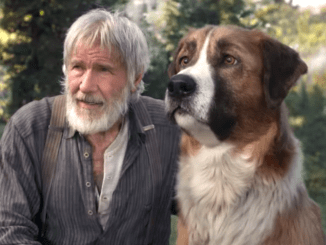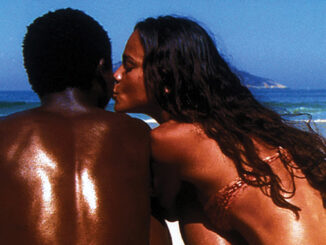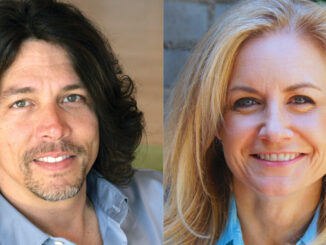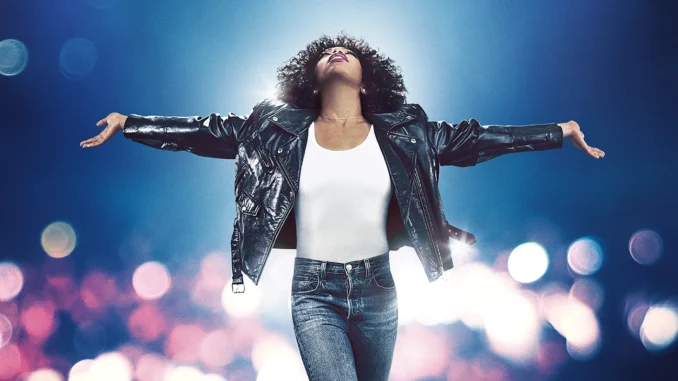
By Patrick Z. McGavin
She’s blessed with the perfect name for a career in show business.
“People always ask me if I made it up,” Daysha Broadway, ACE, said of her name. “I didn’t make it up.”
But it proved prophetic. Now, an Emmy-winner for her work on “A Black Lady Sketch Show,” the Los Angeles native has made her name as a dynamic picture editor whose work stretches from documentaries to short features and reality television.
Now Broadway reflects on her most ambitious project yet, as the lead editor of Kasi Lemmons’ musical biography “Whitney Houston: I Wanna Dance with Somebody,” starring Naomi Ackie as the pop star and actress.
CineMontage: How daunting a challenge was this project?
Daysha Broadway: Daunting is pretty much the word; [it’s] the first time from start to finish I am cutting a feature, and my first theatrical release.
There was a lot piled on. The most daunting part is realizing this was a film about a real person.
I’d mostly done comedies, and I had to switch gears to something more dramatic, a biography of someone who died just 10 years ago, and was somebody still on our mind, somebody who was an icon, and I know people were going to come to the film with their own expectations, their own thoughts. I remember thinking we have to really nail this.
As part of my research, I watched every interview of her I could get my hands on.
That was eye-opening itself, seeing [Houston’s] life chronologically, and seeing her go from this teenager with an amazing voice. The interviews got more honest as they went along, and you could see the shell getting ripped off.
CineMontage: How would you describe your creative dynamic with the director, Kasi Lemmons?
Daysha Broadway: They were shooting in Boston, and I was cutting in Los Angeles. I moved to Boston for three and a half months to do the director’s cut. We spent every day together, 12 to 14 hours a day, and we’d screen the movie every Friday.
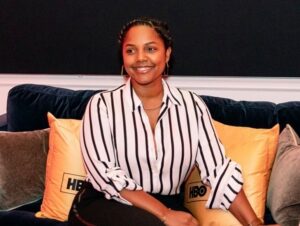
What we talked about from day one was our intentions, what do we want to get out of this, what do we want other people to get out of this. We wanted to be respectful.
We were about to screen my editor’s cut, and she said, “Is it five hours?” The script was lengthy, and the editor’s cut was four hours,16 minutes. I was terrified when I showed her my first cut. She was impressed, and she actually turned to me crying at the end. When we first watched it together, that cut worked.
There are so many beautifully performed scenes by the actors, and we just needed to focus the story, and make sure we are constantly in Whitney’s point of view, and make sure it moves.
CineMontage: One of the crucial decisions has to do with the duration of a particular song. What was that process like
Daysha Broadway: Songs like “Saving All of My Love for You,” were scripted to be played half, and it was written she was just performing the song in the booth. She would laugh at the lyrics for “Where Do Broken Hearts Go,” and I cut it that way initially. I just didn’t think it was dynamic enough. It was not moving.
We sit and hear the song that we have heard before. What are we getting out of it storywise? I pitched this story to Kasi. Whitney’s a fighter in the ring, and I think she needs her own training montage.
I think we need to see her record that first album before her songs are on the radio because it was scripted the other way around. She would hear her songs on the radio and then she would record the songs. I felt like I needed to see a build up to her first song on the radio.
It was always about moving the story forward, and then just having a chance to listen to the songs. We can’t just sit here, and listen to them. We have to give it to the audience in a more dynamic way.
Kasi … just said, “Try it.”
CineMontage: The Super Bowl sequence illustrates the challenge of bringing a fresh eye to such an iconic moment, and reconfiguring it dramatically?
Daysha Broadway: Kasi and the cinematographer Barry Ackroyd just shot the hell out of it, with great camera movement, and it’s very cinematic and dramatic.
The only thing I wanted to make sure of visually were her movements. Whitney has very specific, memorable moments with her arms. She does a lot of waving with her arms when she hits the note, like the way she puts her hands up at the end. Naomi nailed that perfectly, so I wanted to make sure it was in the cut. I didn’t want to cut away from that or around it.
CineMontage: Did you assign each of the different personal connections Whitney negotiates—family, sexual, business—a different tempo?
Daysha Broadway: That is a good point. The pacing at the beginning of the film is much quicker. I liken it to the fact she was a teenager. Everything is a whirlwind, like her relationship with Robyn Crawford (Nafessa Williams).
It’s something that I wanted to move through quickly, and that includes her getting up on stage and doing “Greatest Love of All,” because when you’re a teenager and you love someone and all these things are happening to you, you look back on it, and say, “That was like three days,” and it was actually five years. Everything moves really quickly.
All of these crazy things that you do when you’re 19 or 21 and coming into yourself, you don’t have all the answers. With the pacing, you slam into this, or you slam into that. By the time she meets Bobby Brown (Ashton Sanders), she’s a little older. The pacing was just about trying to put the audience into the shoes of Whitney.
CineMontage: You immediately explore the elephant in the room about Whitney’s sexuality. How did you and Kasi elect to foreground that?
Daysha Broadway: Robyn was always going to be addressed right away in the first act. It was just a longer first act. Kasi and I focused more on Robyn.
We decided we were going to talk about this in the most natural way possible. I suggested we montage a part of them dancing together, smoking a little weed, her songs are on the radio, and they’re having a great time. They’re in love.
My feeling was if they are in a relationship, we should treat them like any straight couple. We would give them their love story, and see them grow together, and then we would rip them apart.
CineMontage: How did Kasi Lemmons’ training and background as an actor shape your interaction on cutting performance, especially the lead performance by Naomi?
Daysha Broadway: It was great because anything that felt inauthentic, Kasi would just rip it out. There wasn’t a lot of that from Naomi. Naomi was fantastic in every inch of film. But there were times where I had to cheat because we didn’t have a close up.
She’d say, “Could you find a different take because it feels actorly.” I’d say, “Naomi gave me the look I needed.” Kasi would say, “That’s the look I need to get out of the scene.”
As an actor, she could feel it being inauthentic. We would find something else, and we’d switch it out. There weren’t many scenes where we had to go and look through the takes because I had chosen motions that she wanted anyway.
CineMontage: What was your journey to get to this moment in your career?
Daysha Broadway: I was obsessed with filmmaking. I loved “Back to the Future” (1986). I loved “Death Becomes Her” (1989). I loved Robert Zemeckis’ films. I loved quirky, weird things. I just loved film, and I loved television.
I didn’t think that this was something that was possible for me. I had never seen anyone do it. I wanted to be an architect. All the women in my family were nurses or in the medical field. Most of the people in my neighborhood were doing that as well because we had a survival instinct. I grew up in Compton, and the survival instinct was you go here, you go there, and then you go to community college and then you get a job that has good benefits so that you could take care of a child that you will inevitably have at the age of 25.
I was very creative, and I was painting all over my walls like Looney Tunes characters and constantly drawing and videotaping my friends. I took apart my computer when my mom got it for me. She wanted to kill me, but I just wanted to know how it worked.
It was actually college when I realized filmmaking was something that I could do as a career. It wasn’t going away. I was obsessed with movies like “City of God” (2002). I think “The Hours” (2002) also came out when I was in college, and it was specifically about the editing, and not the overall filmmaking, performances, that excited me. I went for it, and I never looked back.
CineMontage: How did your eclectic career working in a lot of different formats shape this moment?
Daysha Broadway: All of what we do is about storytelling. I learned a lot about storytelling in reality television because you have to do a lot of it yourself.
As an editor you have to craft things from footage where sometimes there was no real narrative. Working on “Surviving R. Kelly,” for example, it was about a real person, and it was about real people who suffered. That was very useful working on this film.
If there was a situation where I am going to have Whitney say something, I could manipulate that very easily as an editor. I could just move the line over here and then that changes the intention and things like that. You can’t really do that because it’s about a real person.
I think all of past experiences inform every new thing that I do. On “Surviving R Kelly,” I was not going to make this victim say something that she did not say. Working in reality made me a very fast editor. You have deadlines that don’t make any sense. It also just taught me a lot about storytelling that has helped me tremendously.
Patrick Z. McGavin is a Chicago writer and cultural journalist. He maintains the film and culture website, Shadows and Dreams (www.patrickzmcgavin.substack.com).


